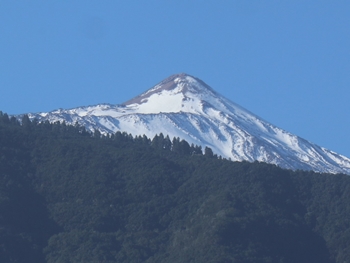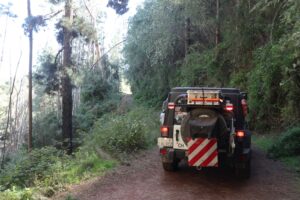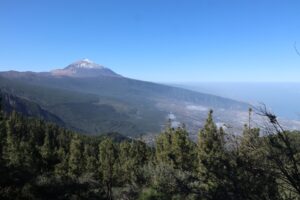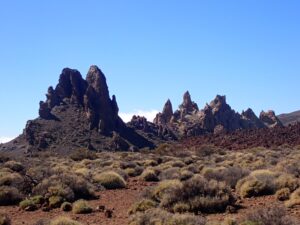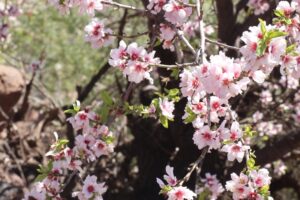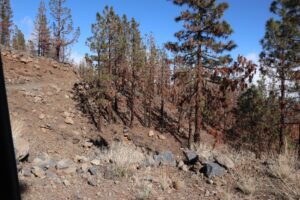>Translated with www.DeepL.com/Translator
(>Pictures at the bottom!)
Gran Canaria is not the largest island of the Canary archipelago; besides Fuerteventura, Tenerife is also much larger and, compared to Fuerteventura, very mountainous. The mountains run through the middle of the island and rise to a high plateau of over 2000 metres, where a few million years ago the Pico del Teide grew to 3718 metres in a massive eruption and is now the highest mountain in Spain. Snow, storms and wintry conditions are nothing unusual around Teide and the summit climb can be closed for weeks.
Surrounding the Teide National Park is the “Parque Natural de Corona Forestal”, which lies like a collar around the Teide and covers a very large area of the island with a pine forest. Immediately following and to the north-east is the wild area of the “Parque Rural de Anaga”.
The north and north-west coasts are favoured with a lot of humidity and allow the vegetation to flourish in all its varieties. It is also the area where most people on the island have settled and cultivate other agricultural products besides bananas.
Actually, everything on Tenerife is steep to very steep; from the highest elevations, the slopes often reach down to the sea. The roads wind along the slopes, climb steeply uphill or fall almost in the fall line towards the sea.
The many tourist facilities are to be found on the south-west as well as the south coast, where people enjoy the sun on the few kilometres of beach or take advantage of the many other offers of the tourist industry. So it is not surprising that next to abandoned banana plantations there are hotel complexes as if from a thousand and one nights, followed by countless ruined buildings and…. a bit of rubbish everywhere!
We enjoyed our trip from Gran Canaria to Tenerife on a fast ferry, which roared over the waves of the Atlantic with a lot of noise and a long cloud of exhaust. No sooner had we got used to the rocking motion than the ferry docked in Sante Cruz de Tenerife. Thanks to a tip from an acquaintance, we went to Playa de las Teresitas just outside in a north-easterly direction, where we spent our first night on the new island. The pleasant temperatures allowed us to stay in front of the jeep for a long time and let our eyes wander out over the wide sea until the starry sky drove us under the warm blanket.
The “Parque Rural de Anaga” above us immediately captivated us and we followed the steep roads up into the mountains. Thanks to the humidity, this area is covered with lush vegetation and invites us to extensive activities with its countless hiking trails. Since Chantal is unable to do too much hiking for health reasons, I chose a shorter ascent of the “Chinobre”. But without special permission, I was not allowed to take this trip of all things. The quota for daily visits had already been allocated for several days, and as a biology student I could not identify myself, who are always entitled to access.
So we shifted towards the Teide National Park and I hoped that maybe I could climb towards the Pico del Teide there. After wonderful tours on the off-road tracks in the “Parque Natural de Corona Forestal”, we reached the high plateau and were somewhat surprised by the wintry conditions. To the north, the Teide was covered with snow and a fresh wind blew across the wide terrain. And to my disillusionment, the path from the top station of the Teide cable car to the summit, which requires a permit, was closed until further notice due to the weather.
So we left the wild volcanic landscape, where the last eruptions almost 300 years ago once again permanently changed the landscape, headed for the forest roads again and enjoyed the vast pine and eucalyptus forests. For us, these forests were a true Eldorado and a quiet camp, far away from any infrastructure or noise, we always found very purposeful. Since the official campsites were still closed – Covid conditioned – we were not too worried about spending the night somewhere in the vast forest. If a ranger had discovered us, it was quite possible that we would have been banned.
On the ferry crossing to the Canary Islands, we met a German couple who own a holiday home near Puerto de la Cruz, and so we accepted their invitation. Along with fine wine from Tenerife, there was a lively exchange of information and many valuable tips for us about the island or what we should definitely not miss.
With many new ideas, we left Puerto de la Cruz, followed lonely paths far up along the nature reserve, before heading west along the coast again. Soon we could no longer ride any other paths or roads than the main connection. Our dream paths all ended in the coastal road leading to the western point of Tenerife.
But even on these roads you can have your adventures. The road is not wide enough for two vehicles to cross each other everywhere, and there is usually a steep slope on the outside, so that when you take evasive action or make a crossing, your heart often beats harder than normal. If another coach comes along, things get exciting and driving backwards is not everyone’s cup of tea. So we scrambled along the west side over countless heights and tourist highlights that are literally drowned by individual tourist traffic.
After the Teno mountains, we followed the tourist areas with the huge holiday and hotel complexes, all of which made a very well-kept impression. The few bays suitable for bathing were well attended despite the still rampant pandemic, and crowded white people lay in the sun. Between the villages, on the other hand, there are banana plantations all the way up, most of them covered with white nets, making the landscape seem somewhat desolate.
More desolate were the many abandoned fields, where the built infrastructure has been left to its fate and the plastic nets are blown in all directions by the wind. Even more frightening are the corners where building ruins are crumbling and the countless rubbish dumps present a somewhat ugly picture. Actually, it is frightening how people treat their world and their capital for tourism.
After the southern tip and Los Cristianos, we slowed down our pace. The weather forecast announced a lot of wind and rain. The south-east coast promised us somewhat drier conditions. With a bit of luck, we found a place to camp for the night, which not every vehicle could immediately approach, and so we had a safe place for the next few days. During the day, we explored the villages, which are all located high up in the slopes of the Teide Mountains, once navigated through the clouds up to the high plateau and were amazed that winter hung stubbornly in the mountains with snow and chill. For one night we stayed up at the border of the nature reserve and were glad to be able to heat our camper in the evening; the thermometer showed a few degrees above zero. Instead, a starry sky and only a dog barking from far away; nothing else.
Our exploration of the never-completed leprosy village on the south-east coast was also an adventure in itself: we followed the ATV tracks via secret paths and somehow found our way into the area. The many visitors present were somewhat puzzled by our right of way, but when we looked for the exit we were irritated and had to search for a long time for a possible emergency exit.
As our perimeter of Tenerife was soon closing and an ascent of Pico del Teide was not feasible for the time being, we booked the ferry to La Gomera. The mountain can wait and on our return to Tenerife we would also like to be able to experience dreams.
Hooray, it’s going to La Gomera – long live island hopping!
>Translated with www.DeepL.com/Translator
